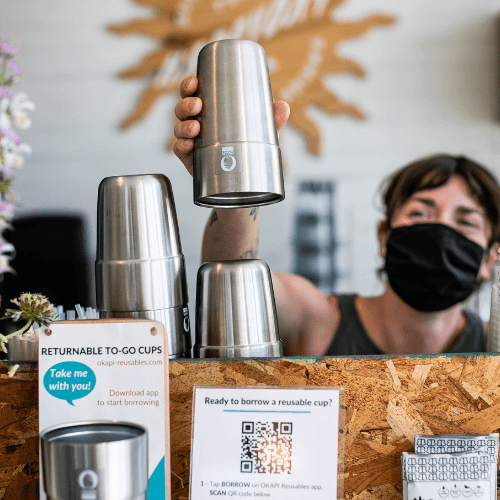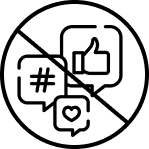Overview
The goal of this project was to design features that increased customer engagement and retention for Okapi Reusable.
OKAPI Reusable is a startup making sustainable impact by partnering with cafes nationwide to provide reusable to-go cups. I worked with a team of 5 students (researchers and designers) in this 6 weeks challenge.
Challenge
Despite growing awareness around sustainability, many cafe-goers still default to single-use cups due to convenience, habit, or lack of incentives.
Okapi Reusable aims to make borrowing and returning reusable cups as seamless and rewarding as possible. The challenge lies in designing a user experience that not only simplifies participation but also builds ongoing engagement and retention.
Design Question
How might we increase participation, engagement, and retention among cafe-goers in borrowing reusable cups through Okapi Reusable?
Client's vision
Give meaning to the act of borrowing
Our client's vision was to leverage storytelling and personal achievement to encourage customers to choose reusables by making the act of borrowing feel meaningful, rewarding, and easy to repeat.
"Every time you order a drink, you author the next chapter in your cup’s story. Choose a disposable cup, and the story ends quickly and wastefully in a landfill. Choose an Okapi reusable cup though, and your cup’s story continues, filled with sustainable adventures and positive impacts." - Okapi Reusable

Personas
Based on prior studies conducted by our client, the primary users of the program are routine-driven cafe-goers.
This group is typically male, aged 30-60, visits cafe multiple times a week, comfortable with technology, and not necessarily motivated by sustainability.
Research: uncovering engagement drivers
We conducted 5 remote interviews with frequent cafe-goers and obtained 50 survey responses.
We used the result to uncover what aspects of a reusable cup program are the most compelling and what additional features would increase participation and engagement.

72%

84%

70%
Competitive Analysis
We researched into other companies focusing on waste reduction to identify common sustainable metrics and engagement features.
KeepCup (Australia)
TooGoodToGo (Denmark)
Aligning on product direction with client
We discussed the research findings with our clients, and decided to raise engagement through the following:
1) Visualizing individual's sustainable impact
Feeling a sense of impact will motivate users to keep contributing and help them see the value of their efforts in a tangible way.
2) Engaging with every borrowed cup
To make each borrowed cup a unique experience, our client wants to highlight the cafe where the cup was borrowed, and the artist behind the cup’s design. This allows users to connect with partner cafes and artists.
3) Showing sustainable stories
Okapi Reusable already sends out monthly newsletter through email to highlight unique sustainable stories from the community. I want to make these stories also accessible from the mobile app, making them easy to browse when users wait in line. Seeing community successes can help users feel a sense of contribution.
Wireframing
We used friendly visuals to create a sense of motivation and encouragement, and color palette from Okapi Reusable's website to create a cohesive look and feel.
Prototyping
Due to time constraint, we created a mid to high-fidelity prototype to test key interactions with the engagement features and gather feedback.
Personal Statistic
Cup's Story
Newsletter
Conducting usability tests
Revise based on feedback on discoverability
I conducted 3 tests (both remote and in-person) using the high-fidelity prototype. Major feedbacks were related to the clarity of navigation and interactive elements:
Emphasize core functionalities of borrowing/returning
Interactive element was unclear
Below shows the original home page design where it wasn't clear the sun was interact-able, and the core functions weren't emphasized. The revision improved the discoverability of interactive elements and core functions.
Final designs
My reflection
We showcased the final prototype to our clients, who expressed excitement about the result and shared plans to build it in the future!
This was my first UX design project. From knowing next to nothing about research, design, and Figma, I learned a lot from my teammates and clients in the short timeframe, and gained more appreciation for all the thought processes involved in creating a product!













